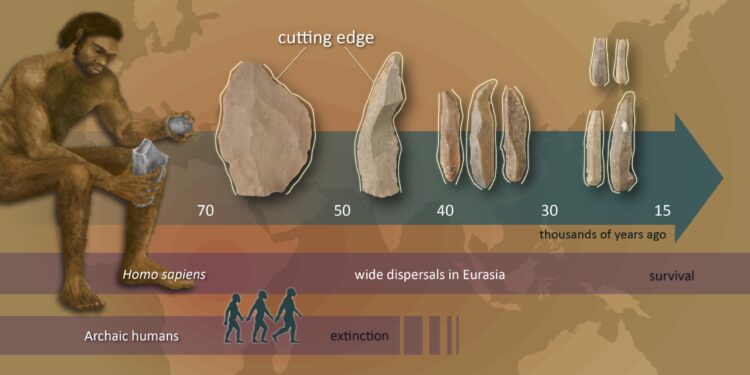The increase in productivity of advanced stone tools (shown in white lines) did not occur before or at the start of the wide dispersals of Homo sapiens in Eurasia, but occurred subsequently after their initial dispersals , coinciding with the development of bladelet technology in the Early Upper Paleolithic. Credit: Reiko Matsushita
A study by researchers at the Nagoya University Museum in Japan could change our understanding of the cultural evolution of Homo sapiens as it dispersed across Eurasia around 50,000 to 40,000 years ago . These findings challenge traditional beliefs about the timing and nature of cultural transitions during this critical period in human history.
Published in Natural communicationsResearchers’ knowledge of stone tool technology suggests that the commonly held view of a “revolution” in culture and technology that allowed anatomically modern humans to supplant Neanderthals and other archaic humans was a process of cultural evolution more nuanced and more complex.
The team of researchers focused on the cultural transition of the Middle-Upper Paleolithic (MP-UP), an important boundary between two key phases of our evolution:
- The Middle Paleolithic period (250,000 to 40,000 years ago) saw anatomically modern humans coexisting with Neanderthals and archaic humans coexisting at the same time. Culturally, anatomically modern humans and Neanderthals had similar stone tool technology, such as making tools using the “Levallois methods”, which involved striking stones with a hammer-like tool.
- The Upper Paleolithic period (50,000 to 12,000 years ago) is the period when anatomically modern humans made vast geographic expansions and archaic humans became extinct. During this period, new cultural elements emerged in various areas, including tool technology, food acquisition, navigation, and artistic expression in ornaments and rock art.
Traditionally, scholars viewed the MP-UP transition as an abrupt change marked by the revolutionary emergence of new cultural elements. One example is the hypothesis of a sudden neuronal mutation in Homo sapiens, which would have resulted in superior cognitive abilities. This change allowed them to supplant other archaic humans and drive the Neanderthals to extinction. However, this study challenges this paradigm.
The researchers examined the productivity of advanced stone tools over a 50,000-year period that encompassed six cultural phases spanning from the late Middle Paleolithic, through the Upper Paleolithic, to the Epipaleolithic period. They found that the major increase in innovative productivity did not occur before or at the start of the widespread dispersal of Homo sapiens across Eurasia. Rather, this occurred subsequently after their initial dispersals, coinciding with the development of bladelet technology in the early Upper Paleolithic.
This result shows a complex process of cultural change involving several stages rather than a single “revolution”.
According to lead researcher Professor Seiji Kadowaki, the cultural transition from the Middle to Upper Paleolithic was a complex evolutionary process involving multiple aspects and changes occurring over a prolonged period.
He said: “In terms of peak productivity, Homo sapiens did not begin to spread across Eurasia after a rapid revolution in stone tool technology, but rather innovation in ‘peak’ productivity began. is produced later, in tandem with miniaturization. stone tools like bladelets.
More information:
Natural communications (2024). DOI: 10.1038/s41467-024-44798-y
Provided by Nagoya University
Quote:Innovation in stone tool technology involved several stages in the era of modern human dispersals, according to study (February 7, 2024) retrieved February 7, 2024 from
This document is subject to copyright. Apart from fair use for private study or research purposes, no part may be reproduced without written permission. The content is provided for information only.



